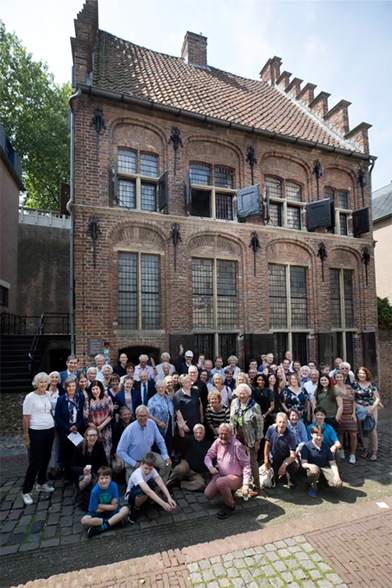Summary in English of De Colve XIV – 2009

Down Under
Cees and Mariëtte Kolff-Reinders (CBCB XVIIIp) describe how – after five years – they finally succeeded in visiting Wally Kolff (CCB XVII-ll) and his wife Judy in Christchurch New Zealand. Wally is the eldest son of Kees and Tora Kolff-Gerretsen (CCB XVIIff). Tora wrote a biography which is available at the website of the association.
Verslag van de Archivaris (Report of the Archivist) 2008
Recent research by Dr. Nouwt has given new insight into the first four generations of our family. Wouter Kolff (or Collaert, Gen. IV), the fourth in line after Henric (Gen. I, as now considered) may well not have been the son of Wouter Petersz Colve, but the son of another Wouter who, in 1490 was an innkeeper at Gorinchem (Gorkum). This Wouter has maybe chosen to take his family name from the game of kolf (which later evolved to golf) that was often played in and around inns in the Low Countries. This Wouter also shipped wine from Breda and Antwerp to Gorinchem. After an incident in 1516 they moved to Oosterwijk. The incident could well have been provoked by the fact that his (as we know now: second) wife Hadewich van den Eijnde over the years gradually alienated from her Gorinchem surroundings and wanted to return to Oosterwijk, where she originated from and where her family still owned property. This is – in short – a reconstruction of what Nouwt has found on the first generations and he will now do further research on them.
Glacier Express
A hobby of some 7000 volunteers leads to the revival of the Dampfbahn Furka Bergstrecke, in short DFB, near the Rhône glacier in the Swiss Alps. This 1920s mountain railway has an interesting history which now comes to a new highlight in the re-opening of the line in 2010. Since 2000 Kees Kolff (CBCF XVIIcc) works a week – every year in August – on the reconstruction: transporting cement to woodcutting for the rails and constructing water pipes for sprinkler installations to avoid forest fires. The work is hard but rewarding and fulfilling. Kees recommends anyone interested to join him in the group of volunteers. Members range from 25 to 82 years of age and – though most are from Switzerland – come from several countries. Who wants to know more can contact Kees (see the article for details).
Een werkzaam leven (A Productive Life): Mr.dr. G.L. Kolff
Liesbeth Kolff (AC XVIe1) contributes a biography of her uncle Gualtherus Kolff (Therus, AC XVId) who has contributed greatly to the prosperity of his native Tielerwaard (a region in the Betuwe, Prov. of Gelderland, between Tiel and Gorinchem). As a young man he studied Law at Utrecht, just as his father and grandfather had done, and when he was appointed as a judge at Geldermalsen he and his wife Nancy had a English style mansion built there, with a beautiful rose garden at the front but also with a number of orchards across from the house. These orchards with fruit trees became his passion. He also nursed an orchard with ancient types of fruit trees. Where Nancy nursed her flowers in the garden, he was always occupied with his fruit trees. Every evening he made a walk through his ‘beloved ones’. Later he worked as a judge at Tiel, but the couple remained living at Geldermalsen. Therus worked hard to improve the economy of the Tielerwaard and one way was to boost the fruit production. He worked to improve the growing of fruit trees, which included the initiative to found an agricultural school. In politics he was a member of the municipal council of Geldermalsen for more than 40 years; a member of the Provincial States for 13 years and a member of the Senate of the Netherlands (Eerste Kamer). For many years he was a senior functionary in the Dutch Reformed church and he held several leading functions in the Waterschap (Water Board) of Beneden Linge. Apart from all this he was a fellow founder of the Boerenleenbank (Farmers Bank) Geldermalsen and of the Farmers Union (now named Welkoop) at Geldermalsen. His productive life ended in 1959 (he was born in 1879). The orchards across the mansion have been cut down: in the near future a new residential area is to be built here.
Kolff Kamer (Kolff Room) at Kampen
On Wednesday November 12, 2008, 65 years after the first treatment with an artificial kidney of a patient, the former office of Prof. Dr. Willem J. Kolff (Pim, CBB XVIIh) in the old Kampen town hospital (Stadsziekenhuisgebouw) was inaugurated as a museum room on Kolff and the artificial kidney. This renovated Kolff Room, an exposition, and a historical walking route are the foundations of a new tourist arrangement the Willem Kolff Stichting want to exploit as a medical-historic attraction. In up keeping the former Stadsziekenhuisgebouw ‘De Engelenbergstichting’ as the main building of IJsselheem the historical importance of this location remains accessible. Not just the unique design of the building (1913-1916, architect Willem Kromhout), but also the invention (1941-1950) of the artificial kidney by Prof. Dr. Willem J. Kolff. As Martien van Goor, architect of the restorations and new additions in 2003 stated: “With the building you keep the story alive”. The Kolff Room was opened by Toos van Noordwijk, widow of the recently deceased assistant of Kolff, Bob van Noordwijk, and Jackie ten Hove, former chair of the Stichting tot Behoud van het Monumentale Ziekenhuisgebouw. Willem Kolff, at the date of the opening of the room 97 years of age and living near Philadelphia, was not present due to his feeble health: he was represented by three of his five children. The Kolff Family Association was represented by the chairman and other members of the family were also present.
| Translations by Marius Kolff (CBCD XVIIw4) |